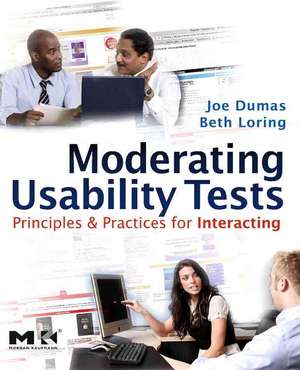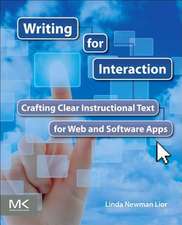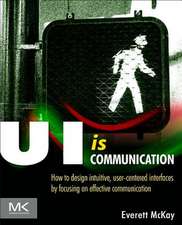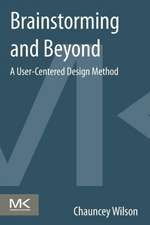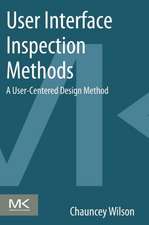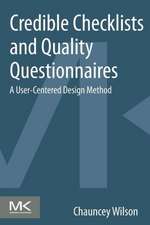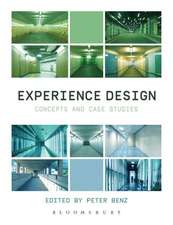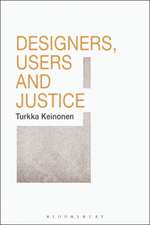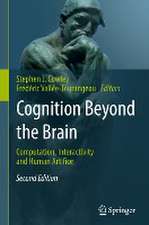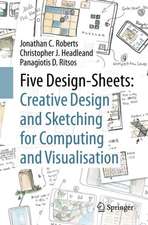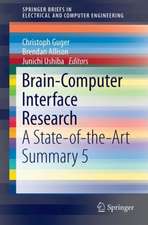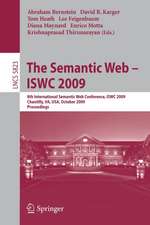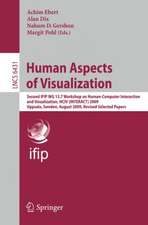Moderating Usability Tests: Principles and Practices for Interacting: Interactive Technologies
Autor Joseph S. Dumas, Beth A. Loringen Limba Engleză Paperback – 9 apr 2008
This book is the resource for new and experienced moderators to learn about the rules and practices for interacting. Authors Dumas and Loring draw on their combined 40 years of usability testing experience to develop and present the most effective principles and practices – both practical and ethical – for moderating successful usability tests. The videos are available from the publisher's companion web site.
- Presents the ten “golden rules that maximize every session’s value
- Offers targeted advice on how to maintain objectivity
- Discusses the ethical considerations that apply in all usability testing
- Explains how to reduce the stress that participants often feel
- Considers the special requirements of remote usability testing
- Demonstrates good and bad moderating techniques with laboratory videos accessible from the publisher’s companion web site
Din seria Interactive Technologies
- 20%
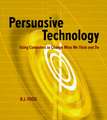 Preț: 310.79 lei
Preț: 310.79 lei - 34%
 Preț: 355.53 lei
Preț: 355.53 lei - 34%
 Preț: 244.47 lei
Preț: 244.47 lei - 20%
 Preț: 291.57 lei
Preț: 291.57 lei - 38%
 Preț: 348.00 lei
Preț: 348.00 lei - 31%
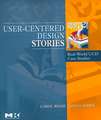 Preț: 306.16 lei
Preț: 306.16 lei - 20%
 Preț: 496.28 lei
Preț: 496.28 lei - 32%
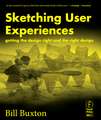 Preț: 229.80 lei
Preț: 229.80 lei - 32%
 Preț: 228.02 lei
Preț: 228.02 lei - 31%
 Preț: 275.36 lei
Preț: 275.36 lei - 31%
 Preț: 359.88 lei
Preț: 359.88 lei - 20%
 Preț: 594.99 lei
Preț: 594.99 lei - 20%
 Preț: 730.82 lei
Preț: 730.82 lei - 8%
 Preț: 227.94 lei
Preț: 227.94 lei - 21%
 Preț: 297.76 lei
Preț: 297.76 lei - 27%
 Preț: 412.82 lei
Preț: 412.82 lei - 20%
 Preț: 410.91 lei
Preț: 410.91 lei - 27%
 Preț: 258.72 lei
Preț: 258.72 lei - 20%
 Preț: 346.23 lei
Preț: 346.23 lei
Preț: 210.27 lei
Preț vechi: 290.96 lei
-28% Nou
Puncte Express: 315
Preț estimativ în valută:
40.24€ • 41.86$ • 33.22£
40.24€ • 41.86$ • 33.22£
Carte tipărită la comandă
Livrare economică 07-21 aprilie
Preluare comenzi: 021 569.72.76
Specificații
ISBN-13: 9780123739339
ISBN-10: 0123739330
Pagini: 208
Ilustrații: Illustrated
Dimensiuni: 191 x 235 x 13 mm
Greutate: 0.43 kg
Editura: ELSEVIER SCIENCE
Seria Interactive Technologies
ISBN-10: 0123739330
Pagini: 208
Ilustrații: Illustrated
Dimensiuni: 191 x 235 x 13 mm
Greutate: 0.43 kg
Editura: ELSEVIER SCIENCE
Seria Interactive Technologies
Public țintă
Usability professionals and software and web design professionals who run usability studies and do user testing, including human factors engineers, usability practitioners/engineers, technical communication professionals, interaction designers, software developers, quality assurance people, and anyone else who needs to do this work.Cuprins
Chapter 1: Introduction
Introduction to the problem
Goals of the book and videos
A brief history of usability testing practice
Part I: The rules of interaction
Chapter 2: Your roles as administrator
The gracious host
The objective observer
The tradeoffs between them
Chapter 3: The Golden Rules -
Part 1: the Five Core Rules
1.The goals of the test and your relationship with developers determine why and when to interact
2.Respect the participants? rights
3.You have a responsibility to future users
4.The participants are the experts; you are in charge
5.Being ?real? is being professional
Chapter 4: The Golden Rules -
Part 2: Five Additional Rules
6.Let the participants speak
7.Your intuition can hurt and help you
8.Be unbiased
9.Don't give away information inadvertently
10.Watch yourself to keep sharp
Part II: Moderating the test session
Chapter 5: First contact ? Setting the tone
Pre-test instructions
Informed consent
Chapter 6: Interacting During the Session
Keeping the participant talking
How much to interact
Providing encouragement
Dealing with stress
Deciding when to give assistance
How to move the participant along
Chapter 7: Post-task activities
What to do first
Taking advantage of their knowledge
Presenting ratings and questionnaires
Making a good last impression
Part III: Special topics
Chapter 8: Interacting in a remote testing session
Preparing for the session
Getting the session started
Interacting when you can't see the participant
Chapter 9: In the Room vs. Out of the Room
Advantages and disadvantages of being in the room
Advantages and disadvantages of being out of the room
Chapter 10: Summing Up
Where do we go from here?
Advice for novice administrators
Introduction to the problem
Goals of the book and videos
A brief history of usability testing practice
Part I: The rules of interaction
Chapter 2: Your roles as administrator
The gracious host
The objective observer
The tradeoffs between them
Chapter 3: The Golden Rules -
Part 1: the Five Core Rules
1.The goals of the test and your relationship with developers determine why and when to interact
2.Respect the participants? rights
3.You have a responsibility to future users
4.The participants are the experts; you are in charge
5.Being ?real? is being professional
Chapter 4: The Golden Rules -
Part 2: Five Additional Rules
6.Let the participants speak
7.Your intuition can hurt and help you
8.Be unbiased
9.Don't give away information inadvertently
10.Watch yourself to keep sharp
Part II: Moderating the test session
Chapter 5: First contact ? Setting the tone
Pre-test instructions
Informed consent
Chapter 6: Interacting During the Session
Keeping the participant talking
How much to interact
Providing encouragement
Dealing with stress
Deciding when to give assistance
How to move the participant along
Chapter 7: Post-task activities
What to do first
Taking advantage of their knowledge
Presenting ratings and questionnaires
Making a good last impression
Part III: Special topics
Chapter 8: Interacting in a remote testing session
Preparing for the session
Getting the session started
Interacting when you can't see the participant
Chapter 9: In the Room vs. Out of the Room
Advantages and disadvantages of being in the room
Advantages and disadvantages of being out of the room
Chapter 10: Summing Up
Where do we go from here?
Advice for novice administrators
Recenzii
"Joe and Beth really know their stuff, and they’ve put together a book that’s enormously valuable for usability professionals and usability amateurs. Whether you’ve conducted hundreds of tests or are about to try your first one, you owe it to yourself--and your team...and your test participants--to read this." --Steve Krug, author of Don’t Make Me Think
"Interacting with participants in a calm and neutral manner may well be the most difficult part of doing usability testing. Now you no longer have to worry about how to do that. Just follow Dumas and Loring's wonderful, practical advice and you will be prepared not only for typical encounters, but also for the unusual and unexpected, for doing remote testing, and for working with special populations. Moderating Usability Tests is a great resource for anyone who interacts with usability test participants." --Janice (Ginny) Redish, President, Redish & Associates, Inc.
"Everyone talks about research methods, but the formal aspects of those methods only get you so far. The difference between getting a little data or a lot of data, only discovering problems or getting ideas about solutions, bias or validity, throw-away data versus generalizable insights, often depend on the soft skills, the ability to effectively moderate testing. In the past, you were expected to get these skills through apprenticeships or trial and error. Moderating Usability Tests: Principles for Interacting with Participants removes the mystery and provides practical advice on how to get the most out of research. It will be invaluable to students learning about usability testing for the first time, people newly charged with evaluating products, and even old hands looking to refine and improve their technique." --Arnold Lund, Director of User Experience, Microsoft
"You may not think that being a “Gracious Host is among your assignments in moderating a usability test, but you will learn why this and other roles with similarly illuminating names are important to your success. In this generous book, Dumas and Loring give the benefit of their decades of experience and astute observation of both the foundational and the subtle aspects of conducting usability tests. Many questions you didn't think to ask until you were on the hot seat are answered here, and will help you achieve a level of confidence as a test moderator that may have seemed beyond reach, even if your participants are from challenging-to-test populations. With this highly ethical and thoroughly grounded program for developing moderator skills and avoiding pitfalls, Dumas and Loring make a strong contribution to the body of knowledge on testing products. The big surprise of the book is that their clear, reasoned, and detailed suggestions about interacting with test participants and developers will likely spill over and improve your relationships with co-workers, family, neighbors, and friends." --Elisabeth Bayle, Bayle Collaborations
"At this point, virtually everyone in the software industry knows what usability testing is. An unfortunate side effect of this awareness is that many people are conducting usability testing who have no idea how to do so in a way that will yield valid, reliable and useful data. Other than the design of the test itself, proper and effective moderation of test sessions is one of the most important - and least understood - aspects of usability testing. Here is a book by two highly regarded experts that covers this topic thoroughly in a very readable format. No one who has not already been well trained should attempt to conduct usability testing without first reading this book cover to cover, and viewing all the excellent videos the authors provide." --Deborah J. Mayhew, Deborah J. Mayhew & Associates
"Interacting with participants in a calm and neutral manner may well be the most difficult part of doing usability testing. Now you no longer have to worry about how to do that. Just follow Dumas and Loring's wonderful, practical advice and you will be prepared not only for typical encounters, but also for the unusual and unexpected, for doing remote testing, and for working with special populations. Moderating Usability Tests is a great resource for anyone who interacts with usability test participants." --Janice (Ginny) Redish, President, Redish & Associates, Inc.
"Everyone talks about research methods, but the formal aspects of those methods only get you so far. The difference between getting a little data or a lot of data, only discovering problems or getting ideas about solutions, bias or validity, throw-away data versus generalizable insights, often depend on the soft skills, the ability to effectively moderate testing. In the past, you were expected to get these skills through apprenticeships or trial and error. Moderating Usability Tests: Principles for Interacting with Participants removes the mystery and provides practical advice on how to get the most out of research. It will be invaluable to students learning about usability testing for the first time, people newly charged with evaluating products, and even old hands looking to refine and improve their technique." --Arnold Lund, Director of User Experience, Microsoft
"You may not think that being a “Gracious Host is among your assignments in moderating a usability test, but you will learn why this and other roles with similarly illuminating names are important to your success. In this generous book, Dumas and Loring give the benefit of their decades of experience and astute observation of both the foundational and the subtle aspects of conducting usability tests. Many questions you didn't think to ask until you were on the hot seat are answered here, and will help you achieve a level of confidence as a test moderator that may have seemed beyond reach, even if your participants are from challenging-to-test populations. With this highly ethical and thoroughly grounded program for developing moderator skills and avoiding pitfalls, Dumas and Loring make a strong contribution to the body of knowledge on testing products. The big surprise of the book is that their clear, reasoned, and detailed suggestions about interacting with test participants and developers will likely spill over and improve your relationships with co-workers, family, neighbors, and friends." --Elisabeth Bayle, Bayle Collaborations
"At this point, virtually everyone in the software industry knows what usability testing is. An unfortunate side effect of this awareness is that many people are conducting usability testing who have no idea how to do so in a way that will yield valid, reliable and useful data. Other than the design of the test itself, proper and effective moderation of test sessions is one of the most important - and least understood - aspects of usability testing. Here is a book by two highly regarded experts that covers this topic thoroughly in a very readable format. No one who has not already been well trained should attempt to conduct usability testing without first reading this book cover to cover, and viewing all the excellent videos the authors provide." --Deborah J. Mayhew, Deborah J. Mayhew & Associates
